Foreign Exchange Risk Exposure Analysis in International Finance
VerifiedAdded on 2024/04/25
|12
|1468
|422
Report
AI Summary
This report provides an overview of foreign exchange risk exposure, focusing on its implications for a company expanding internationally, specifically an Australian company venturing into China. It identifies debt financing and translation exposure as key risk factors. The report discusses the application of capital budgeting techniques for feasibility assessments, including adjusted Net Present Value and real options. It also explores the advantages of borrowing funds in the target country to minimize translation exposure, weighing this against potential equity dilution. The report further analyzes factors influencing currency borrowing decisions, the impact of foreign exchange translation exposure, and key considerations for short-term fund investments, including interest rates, investment avenues, and regulatory impacts on fund transfers. It concludes that strategic decisions regarding borrowing and investment in foreign currencies require careful evaluation of various financial and regulatory aspects.
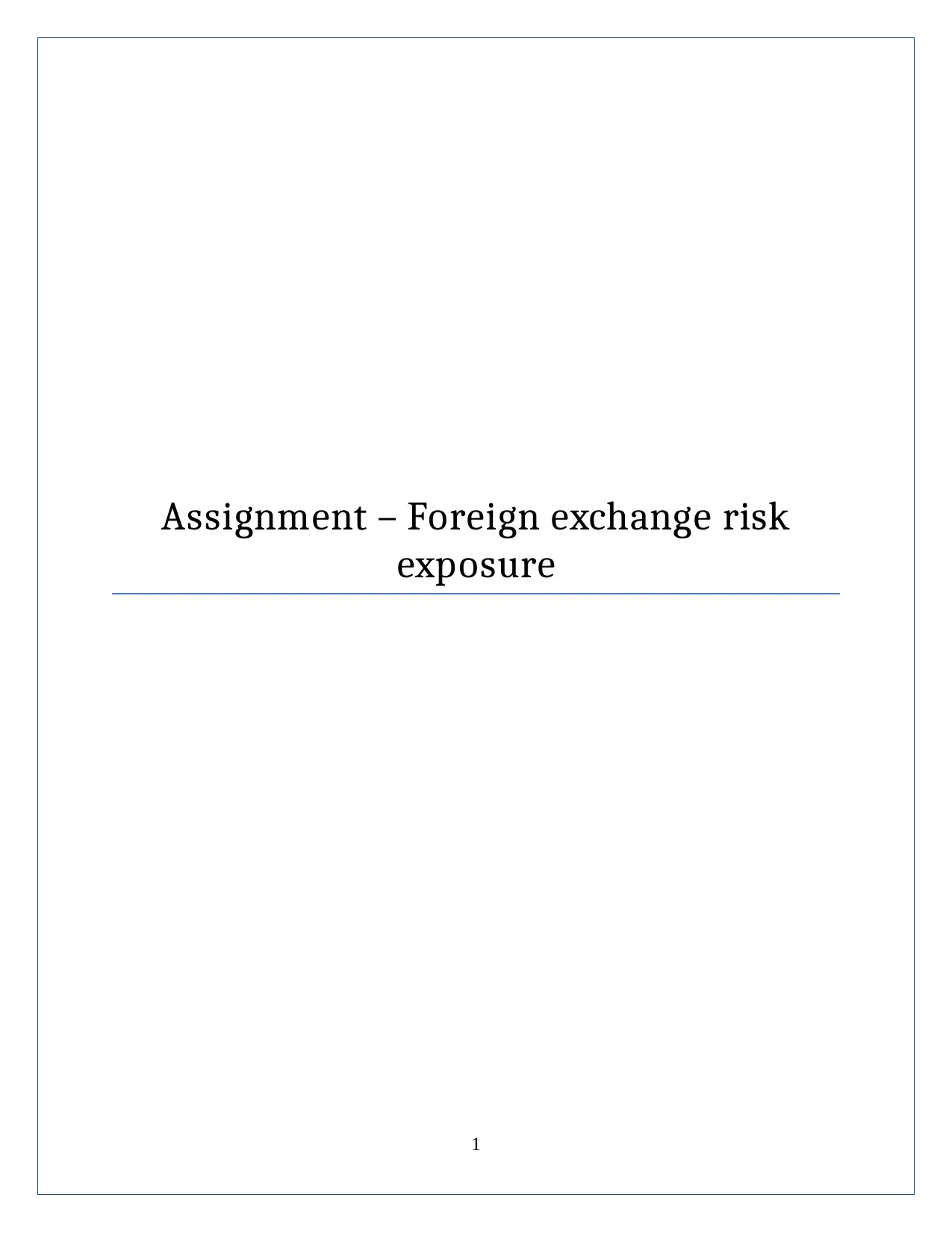
Assignment – Foreign exchange risk
exposure
1
exposure
1
Paraphrase This Document
Need a fresh take? Get an instant paraphrase of this document with our AI Paraphraser
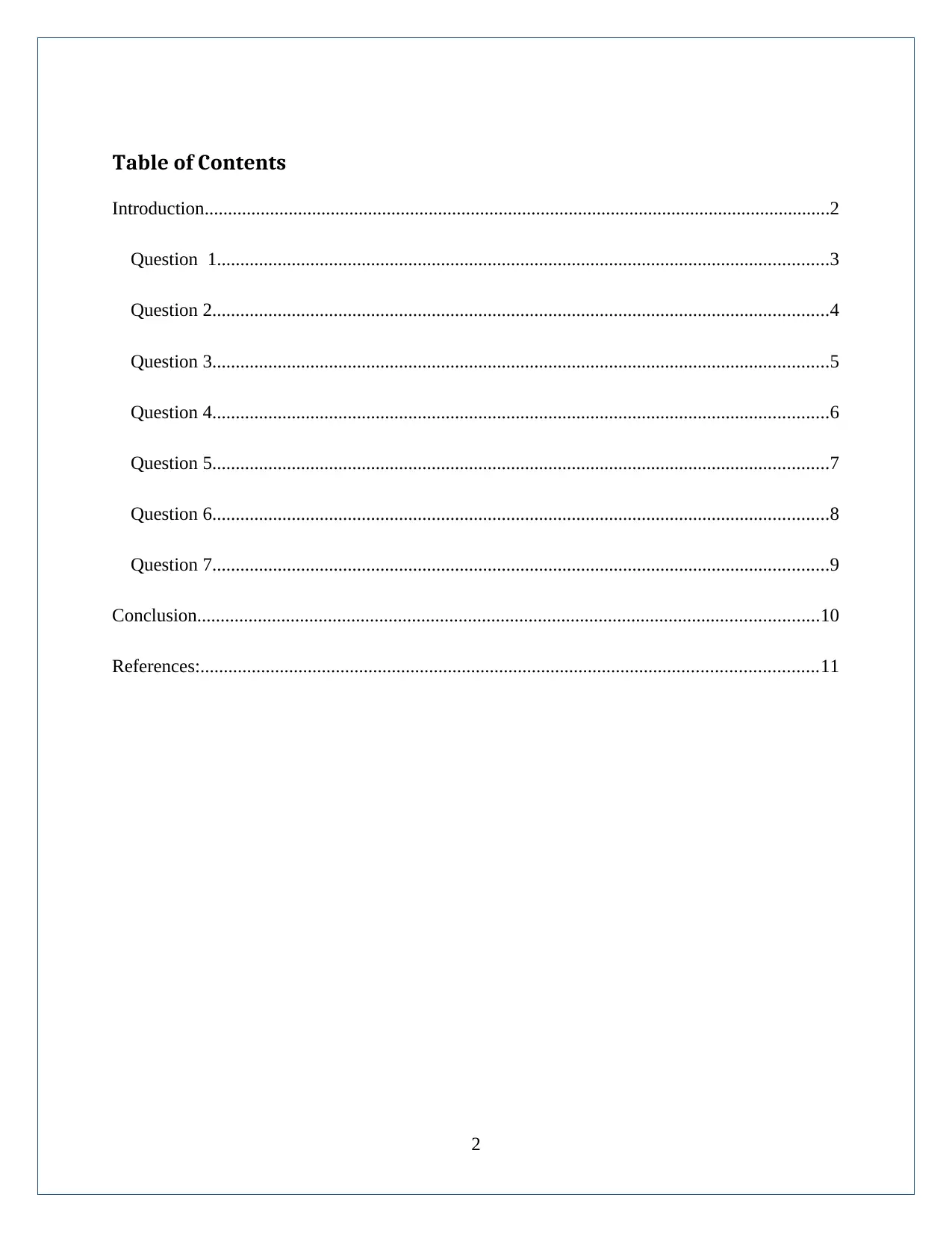
Table of Contents
Introduction......................................................................................................................................2
Question 1...................................................................................................................................3
Question 2....................................................................................................................................4
Question 3....................................................................................................................................5
Question 4....................................................................................................................................6
Question 5....................................................................................................................................7
Question 6....................................................................................................................................8
Question 7....................................................................................................................................9
Conclusion.....................................................................................................................................10
References:....................................................................................................................................11
2
Introduction......................................................................................................................................2
Question 1...................................................................................................................................3
Question 2....................................................................................................................................4
Question 3....................................................................................................................................5
Question 4....................................................................................................................................6
Question 5....................................................................................................................................7
Question 6....................................................................................................................................8
Question 7....................................................................................................................................9
Conclusion.....................................................................................................................................10
References:....................................................................................................................................11
2
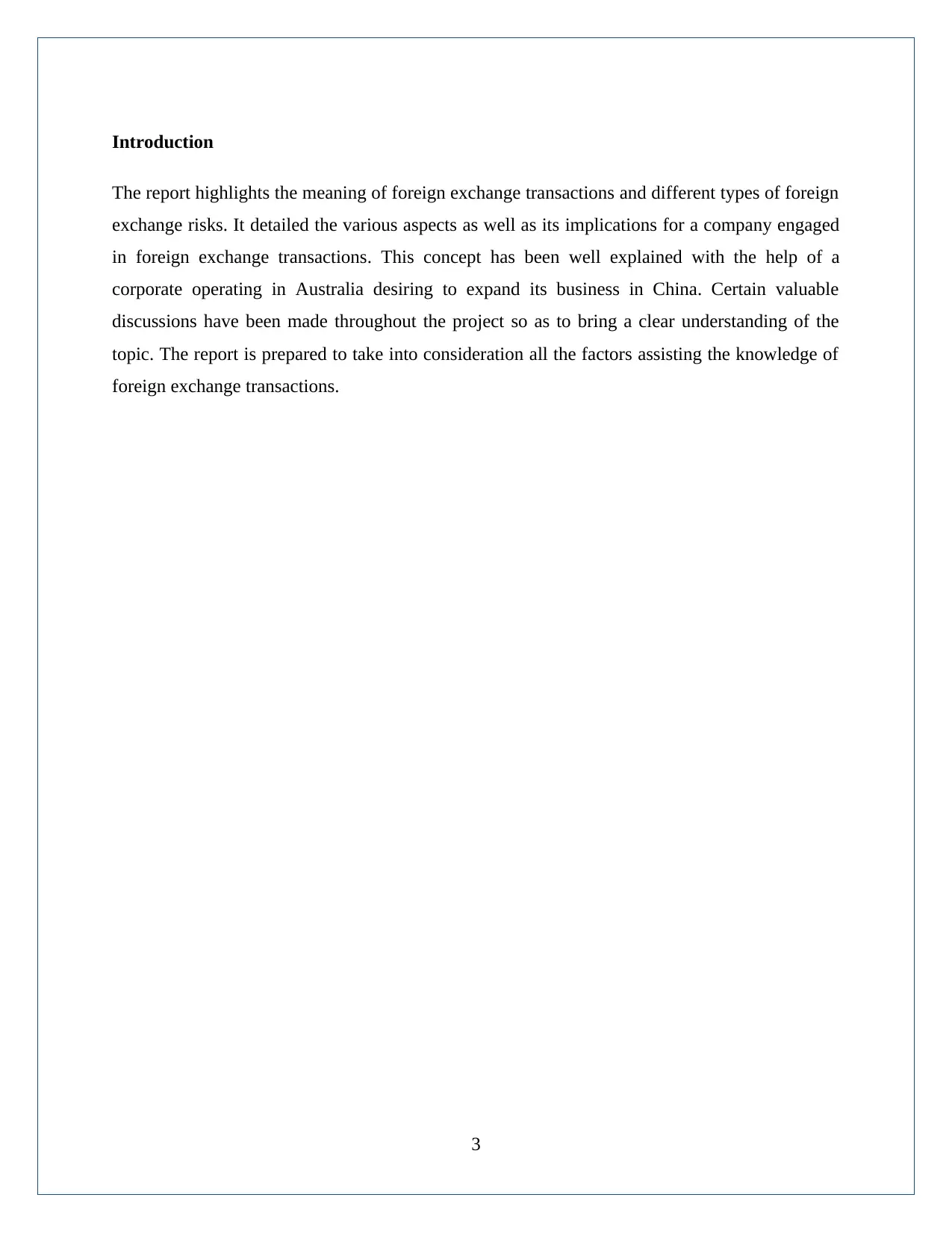
Introduction
The report highlights the meaning of foreign exchange transactions and different types of foreign
exchange risks. It detailed the various aspects as well as its implications for a company engaged
in foreign exchange transactions. This concept has been well explained with the help of a
corporate operating in Australia desiring to expand its business in China. Certain valuable
discussions have been made throughout the project so as to bring a clear understanding of the
topic. The report is prepared to take into consideration all the factors assisting the knowledge of
foreign exchange transactions.
3
The report highlights the meaning of foreign exchange transactions and different types of foreign
exchange risks. It detailed the various aspects as well as its implications for a company engaged
in foreign exchange transactions. This concept has been well explained with the help of a
corporate operating in Australia desiring to expand its business in China. Certain valuable
discussions have been made throughout the project so as to bring a clear understanding of the
topic. The report is prepared to take into consideration all the factors assisting the knowledge of
foreign exchange transactions.
3
⊘ This is a preview!⊘
Do you want full access?
Subscribe today to unlock all pages.

Trusted by 1+ million students worldwide
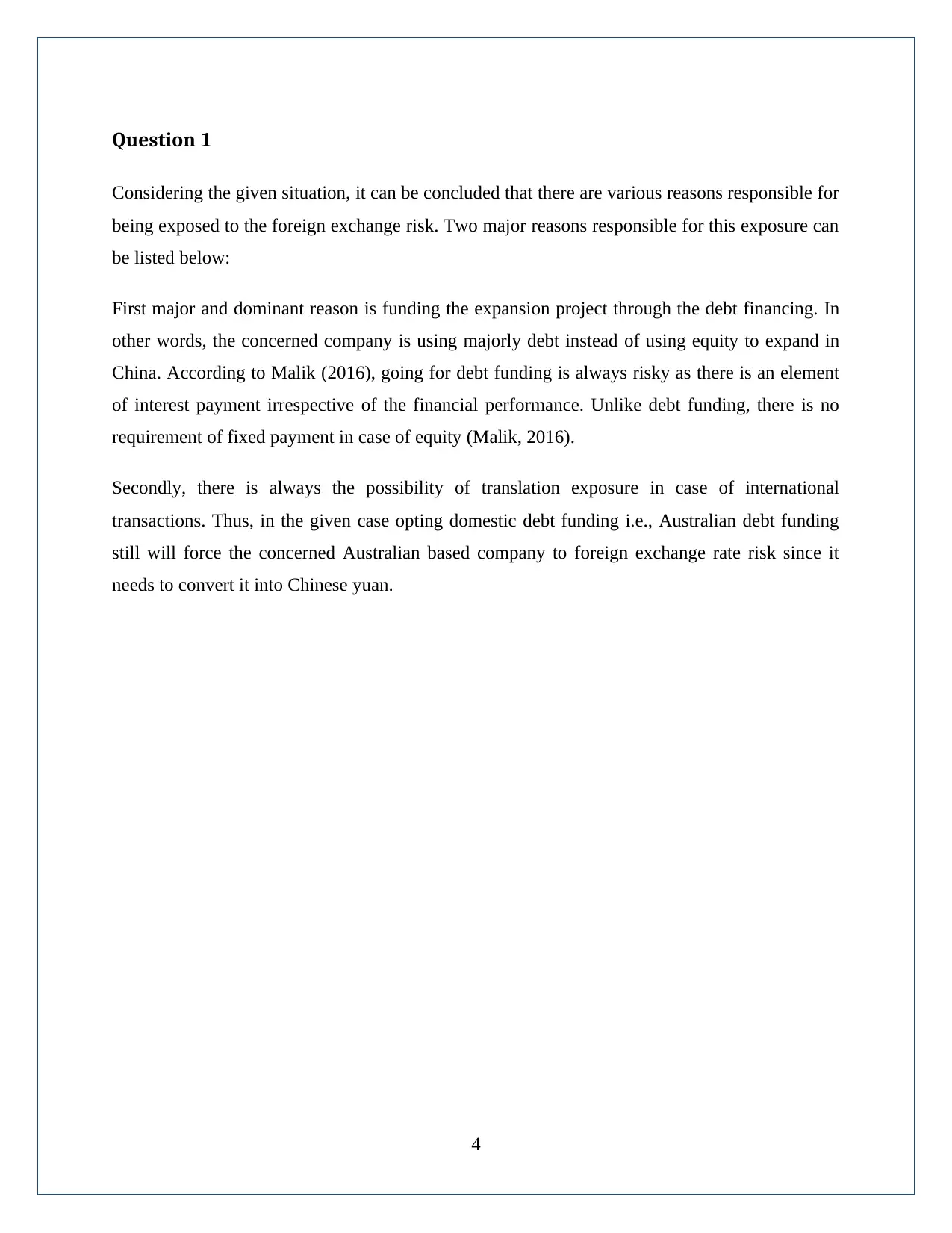
Question 1
Considering the given situation, it can be concluded that there are various reasons responsible for
being exposed to the foreign exchange risk. Two major reasons responsible for this exposure can
be listed below:
First major and dominant reason is funding the expansion project through the debt financing. In
other words, the concerned company is using majorly debt instead of using equity to expand in
China. According to Malik (2016), going for debt funding is always risky as there is an element
of interest payment irrespective of the financial performance. Unlike debt funding, there is no
requirement of fixed payment in case of equity (Malik, 2016).
Secondly, there is always the possibility of translation exposure in case of international
transactions. Thus, in the given case opting domestic debt funding i.e., Australian debt funding
still will force the concerned Australian based company to foreign exchange rate risk since it
needs to convert it into Chinese yuan.
4
Considering the given situation, it can be concluded that there are various reasons responsible for
being exposed to the foreign exchange risk. Two major reasons responsible for this exposure can
be listed below:
First major and dominant reason is funding the expansion project through the debt financing. In
other words, the concerned company is using majorly debt instead of using equity to expand in
China. According to Malik (2016), going for debt funding is always risky as there is an element
of interest payment irrespective of the financial performance. Unlike debt funding, there is no
requirement of fixed payment in case of equity (Malik, 2016).
Secondly, there is always the possibility of translation exposure in case of international
transactions. Thus, in the given case opting domestic debt funding i.e., Australian debt funding
still will force the concerned Australian based company to foreign exchange rate risk since it
needs to convert it into Chinese yuan.
4
Paraphrase This Document
Need a fresh take? Get an instant paraphrase of this document with our AI Paraphraser
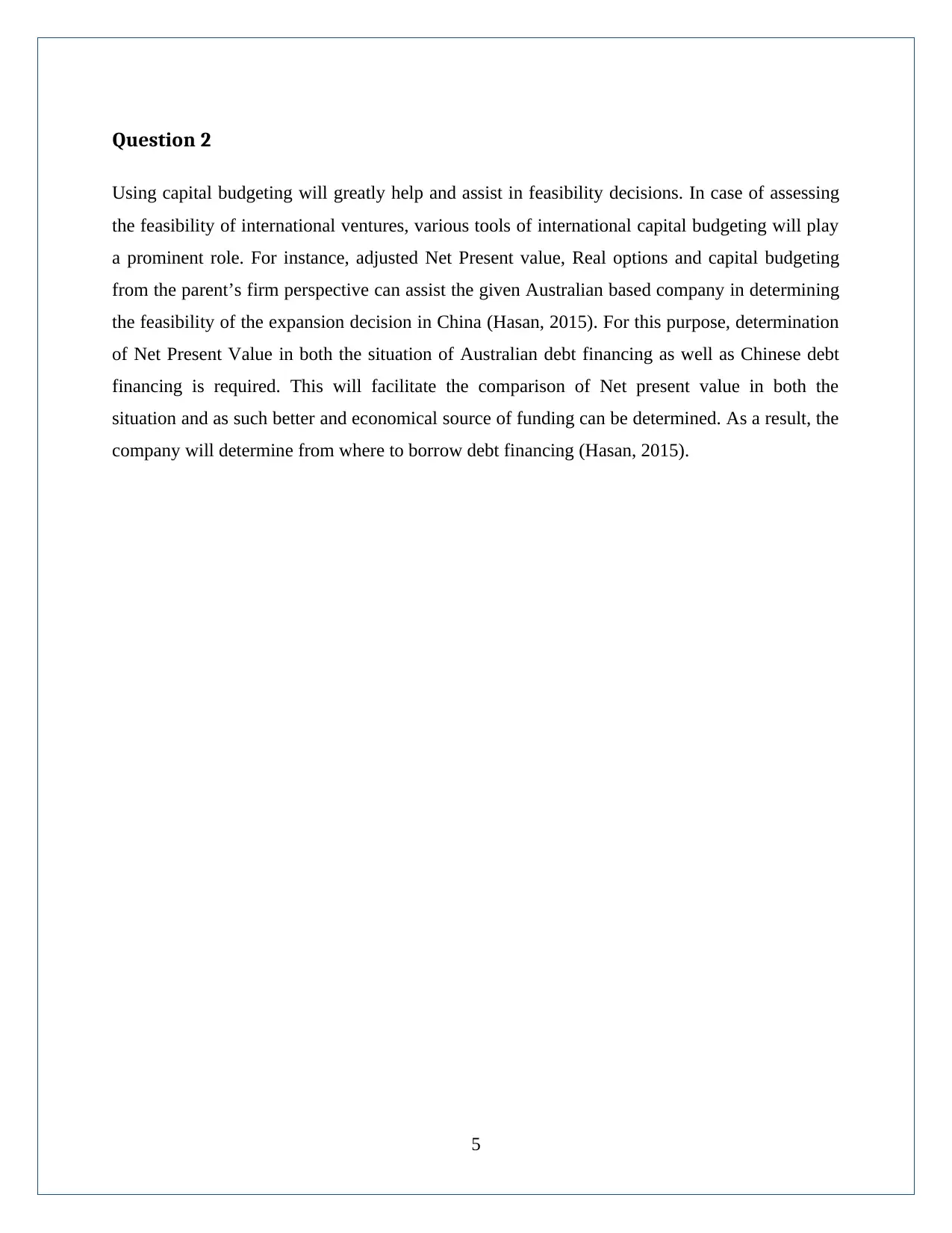
Question 2
Using capital budgeting will greatly help and assist in feasibility decisions. In case of assessing
the feasibility of international ventures, various tools of international capital budgeting will play
a prominent role. For instance, adjusted Net Present value, Real options and capital budgeting
from the parent’s firm perspective can assist the given Australian based company in determining
the feasibility of the expansion decision in China (Hasan, 2015). For this purpose, determination
of Net Present Value in both the situation of Australian debt financing as well as Chinese debt
financing is required. This will facilitate the comparison of Net present value in both the
situation and as such better and economical source of funding can be determined. As a result, the
company will determine from where to borrow debt financing (Hasan, 2015).
5
Using capital budgeting will greatly help and assist in feasibility decisions. In case of assessing
the feasibility of international ventures, various tools of international capital budgeting will play
a prominent role. For instance, adjusted Net Present value, Real options and capital budgeting
from the parent’s firm perspective can assist the given Australian based company in determining
the feasibility of the expansion decision in China (Hasan, 2015). For this purpose, determination
of Net Present Value in both the situation of Australian debt financing as well as Chinese debt
financing is required. This will facilitate the comparison of Net present value in both the
situation and as such better and economical source of funding can be determined. As a result, the
company will determine from where to borrow debt financing (Hasan, 2015).
5
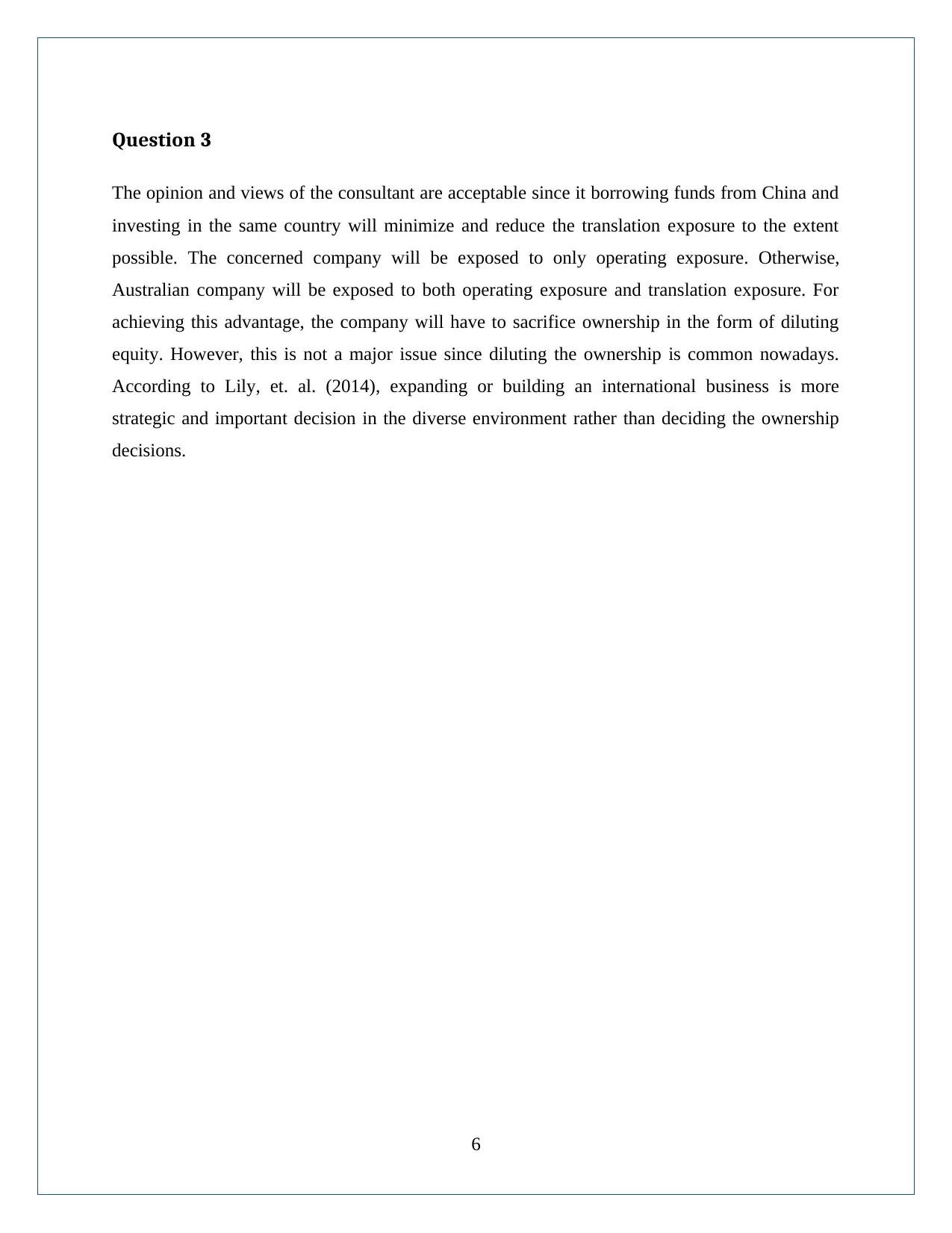
Question 3
The opinion and views of the consultant are acceptable since it borrowing funds from China and
investing in the same country will minimize and reduce the translation exposure to the extent
possible. The concerned company will be exposed to only operating exposure. Otherwise,
Australian company will be exposed to both operating exposure and translation exposure. For
achieving this advantage, the company will have to sacrifice ownership in the form of diluting
equity. However, this is not a major issue since diluting the ownership is common nowadays.
According to Lily, et. al. (2014), expanding or building an international business is more
strategic and important decision in the diverse environment rather than deciding the ownership
decisions.
6
The opinion and views of the consultant are acceptable since it borrowing funds from China and
investing in the same country will minimize and reduce the translation exposure to the extent
possible. The concerned company will be exposed to only operating exposure. Otherwise,
Australian company will be exposed to both operating exposure and translation exposure. For
achieving this advantage, the company will have to sacrifice ownership in the form of diluting
equity. However, this is not a major issue since diluting the ownership is common nowadays.
According to Lily, et. al. (2014), expanding or building an international business is more
strategic and important decision in the diverse environment rather than deciding the ownership
decisions.
6
⊘ This is a preview!⊘
Do you want full access?
Subscribe today to unlock all pages.

Trusted by 1+ million students worldwide
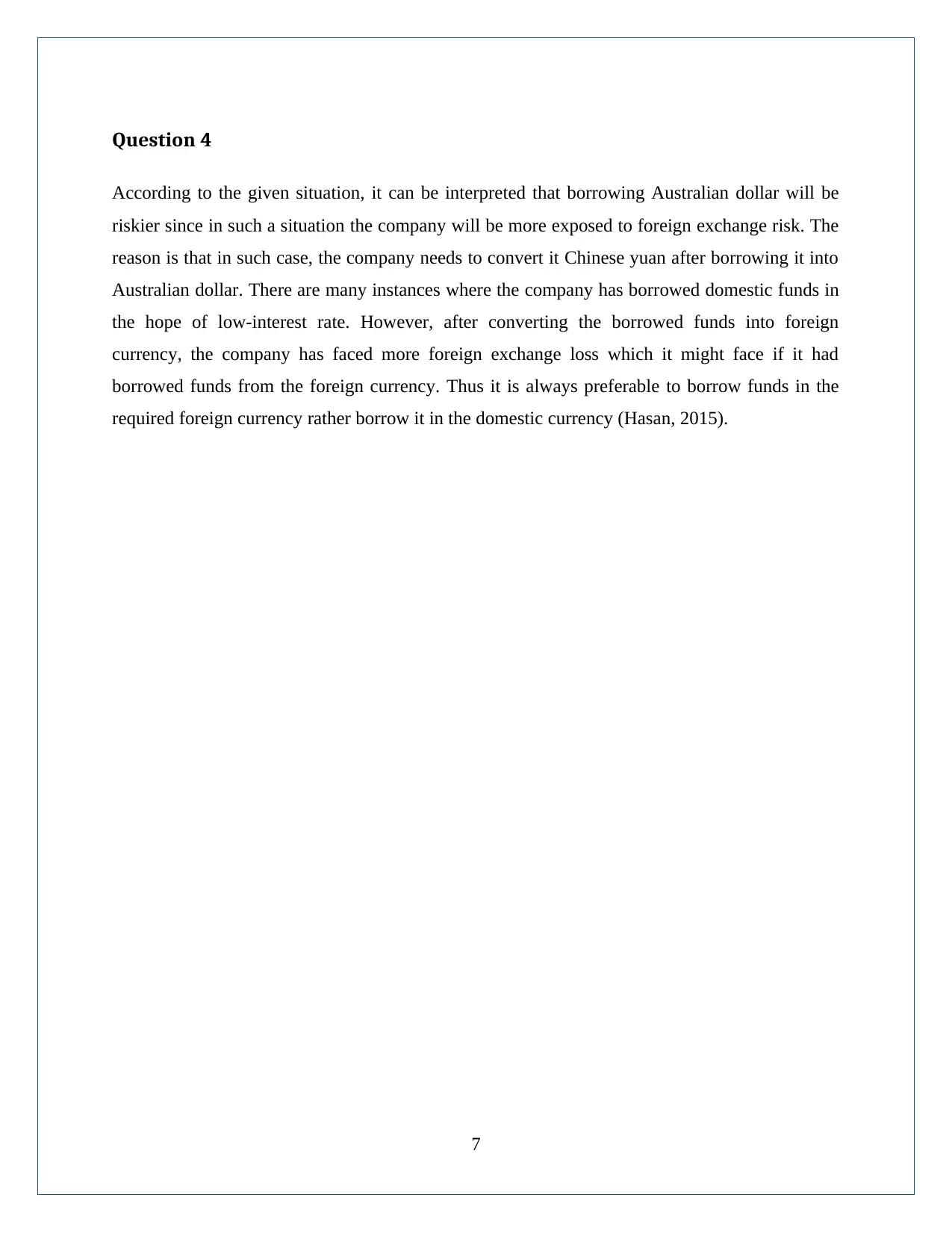
Question 4
According to the given situation, it can be interpreted that borrowing Australian dollar will be
riskier since in such a situation the company will be more exposed to foreign exchange risk. The
reason is that in such case, the company needs to convert it Chinese yuan after borrowing it into
Australian dollar. There are many instances where the company has borrowed domestic funds in
the hope of low-interest rate. However, after converting the borrowed funds into foreign
currency, the company has faced more foreign exchange loss which it might face if it had
borrowed funds from the foreign currency. Thus it is always preferable to borrow funds in the
required foreign currency rather borrow it in the domestic currency (Hasan, 2015).
7
According to the given situation, it can be interpreted that borrowing Australian dollar will be
riskier since in such a situation the company will be more exposed to foreign exchange risk. The
reason is that in such case, the company needs to convert it Chinese yuan after borrowing it into
Australian dollar. There are many instances where the company has borrowed domestic funds in
the hope of low-interest rate. However, after converting the borrowed funds into foreign
currency, the company has faced more foreign exchange loss which it might face if it had
borrowed funds from the foreign currency. Thus it is always preferable to borrow funds in the
required foreign currency rather borrow it in the domestic currency (Hasan, 2015).
7
Paraphrase This Document
Need a fresh take? Get an instant paraphrase of this document with our AI Paraphraser
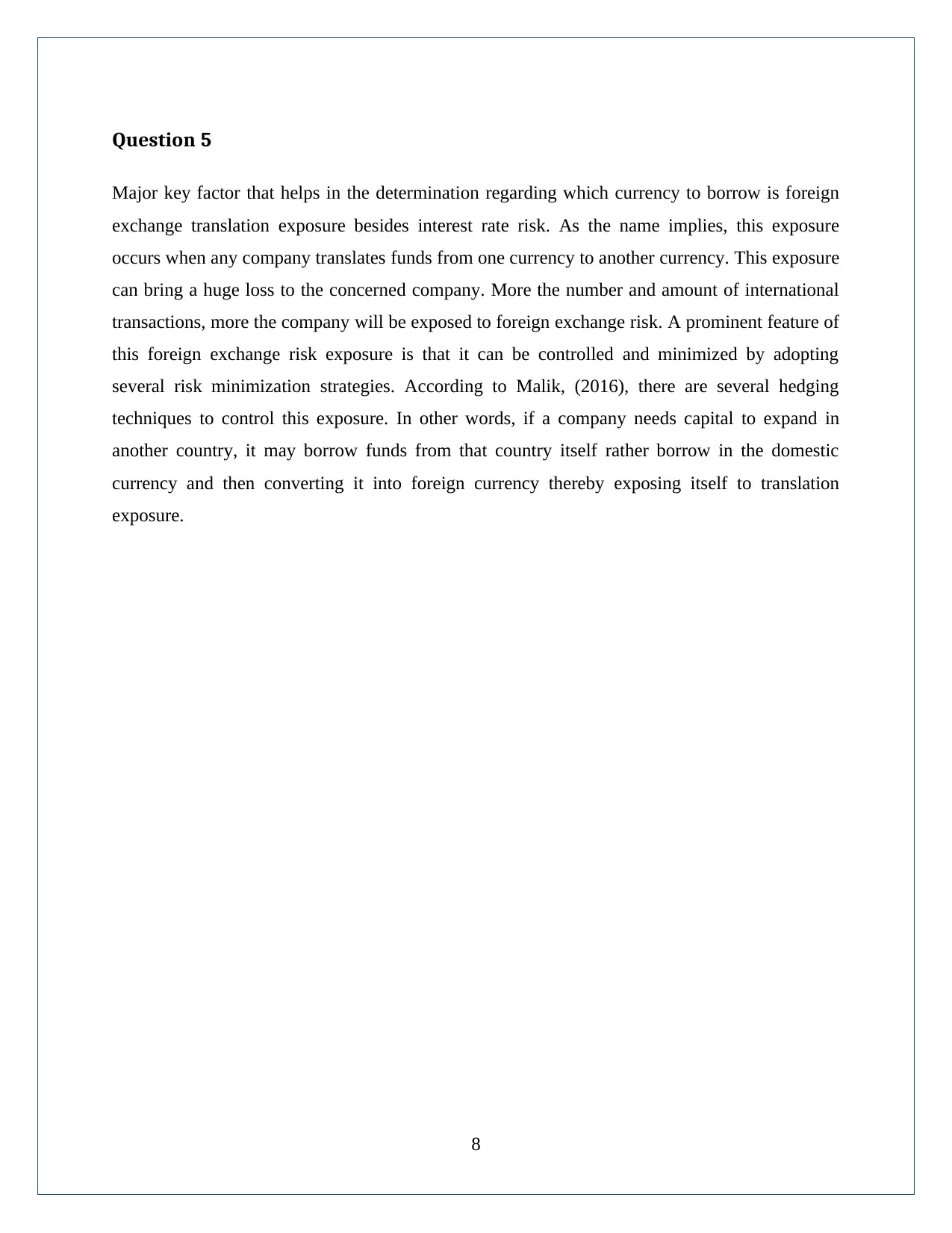
Question 5
Major key factor that helps in the determination regarding which currency to borrow is foreign
exchange translation exposure besides interest rate risk. As the name implies, this exposure
occurs when any company translates funds from one currency to another currency. This exposure
can bring a huge loss to the concerned company. More the number and amount of international
transactions, more the company will be exposed to foreign exchange risk. A prominent feature of
this foreign exchange risk exposure is that it can be controlled and minimized by adopting
several risk minimization strategies. According to Malik, (2016), there are several hedging
techniques to control this exposure. In other words, if a company needs capital to expand in
another country, it may borrow funds from that country itself rather borrow in the domestic
currency and then converting it into foreign currency thereby exposing itself to translation
exposure.
8
Major key factor that helps in the determination regarding which currency to borrow is foreign
exchange translation exposure besides interest rate risk. As the name implies, this exposure
occurs when any company translates funds from one currency to another currency. This exposure
can bring a huge loss to the concerned company. More the number and amount of international
transactions, more the company will be exposed to foreign exchange risk. A prominent feature of
this foreign exchange risk exposure is that it can be controlled and minimized by adopting
several risk minimization strategies. According to Malik, (2016), there are several hedging
techniques to control this exposure. In other words, if a company needs capital to expand in
another country, it may borrow funds from that country itself rather borrow in the domestic
currency and then converting it into foreign currency thereby exposing itself to translation
exposure.
8
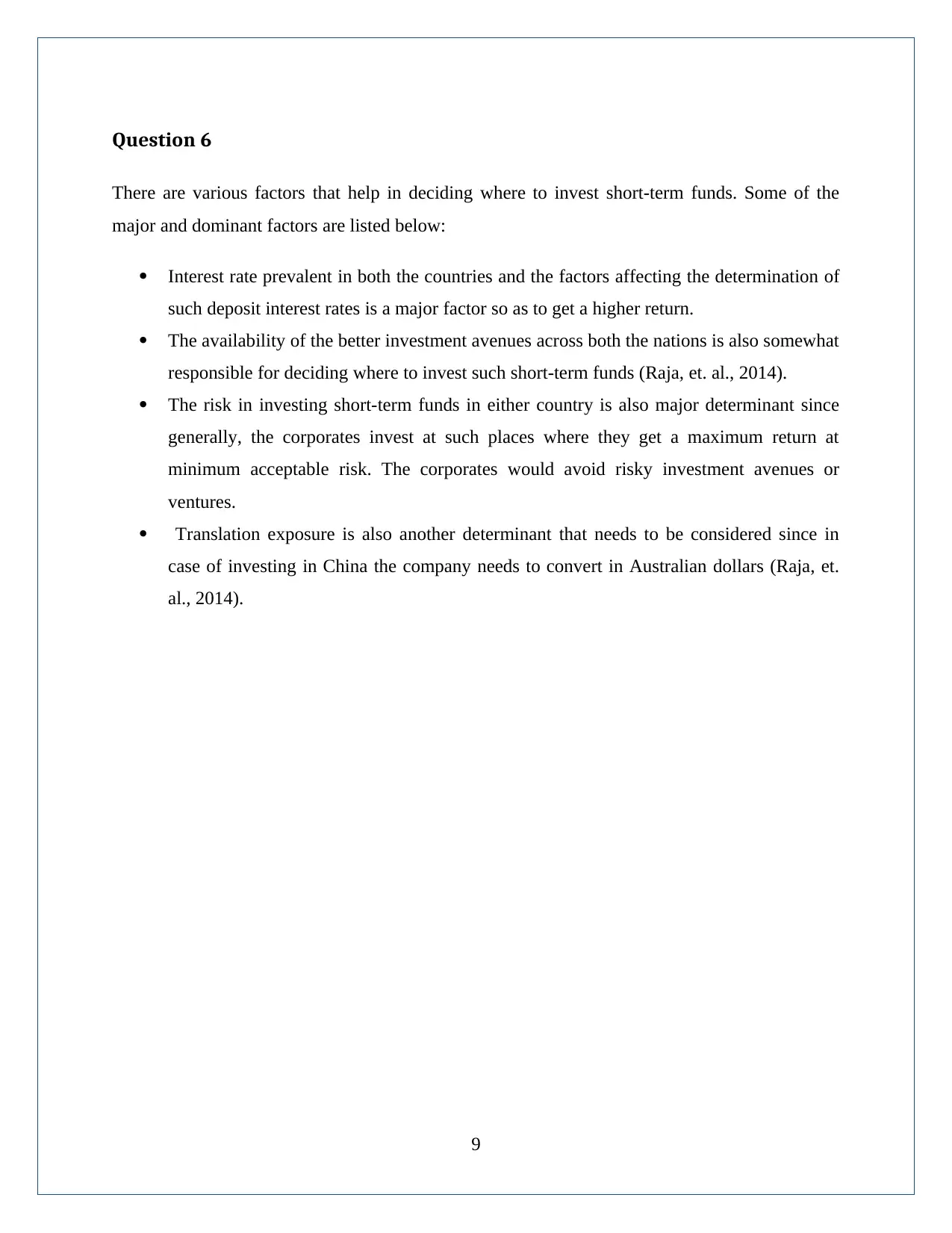
Question 6
There are various factors that help in deciding where to invest short-term funds. Some of the
major and dominant factors are listed below:
Interest rate prevalent in both the countries and the factors affecting the determination of
such deposit interest rates is a major factor so as to get a higher return.
The availability of the better investment avenues across both the nations is also somewhat
responsible for deciding where to invest such short-term funds (Raja, et. al., 2014).
The risk in investing short-term funds in either country is also major determinant since
generally, the corporates invest at such places where they get a maximum return at
minimum acceptable risk. The corporates would avoid risky investment avenues or
ventures.
Translation exposure is also another determinant that needs to be considered since in
case of investing in China the company needs to convert in Australian dollars (Raja, et.
al., 2014).
9
There are various factors that help in deciding where to invest short-term funds. Some of the
major and dominant factors are listed below:
Interest rate prevalent in both the countries and the factors affecting the determination of
such deposit interest rates is a major factor so as to get a higher return.
The availability of the better investment avenues across both the nations is also somewhat
responsible for deciding where to invest such short-term funds (Raja, et. al., 2014).
The risk in investing short-term funds in either country is also major determinant since
generally, the corporates invest at such places where they get a maximum return at
minimum acceptable risk. The corporates would avoid risky investment avenues or
ventures.
Translation exposure is also another determinant that needs to be considered since in
case of investing in China the company needs to convert in Australian dollars (Raja, et.
al., 2014).
9
⊘ This is a preview!⊘
Do you want full access?
Subscribe today to unlock all pages.

Trusted by 1+ million students worldwide
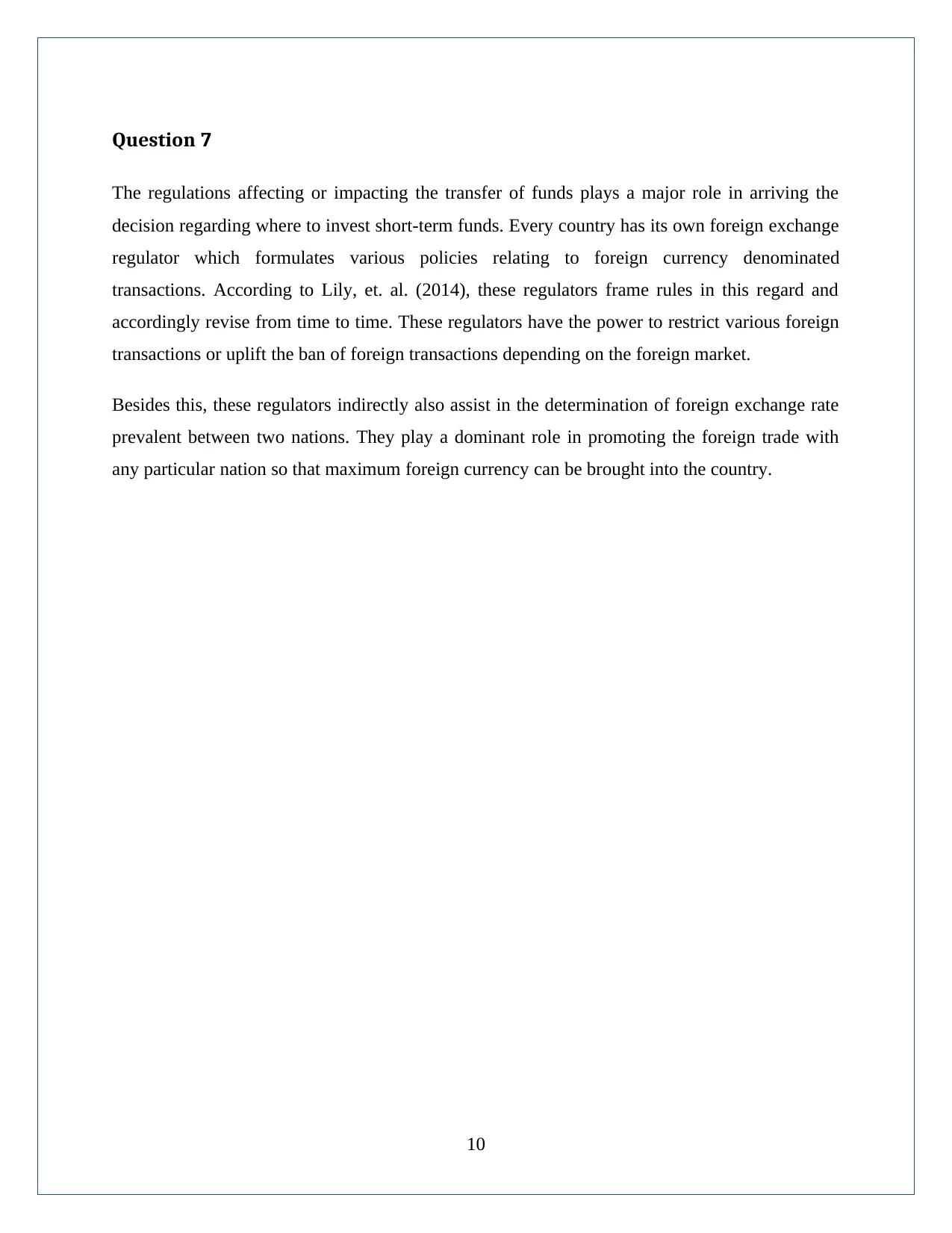
Question 7
The regulations affecting or impacting the transfer of funds plays a major role in arriving the
decision regarding where to invest short-term funds. Every country has its own foreign exchange
regulator which formulates various policies relating to foreign currency denominated
transactions. According to Lily, et. al. (2014), these regulators frame rules in this regard and
accordingly revise from time to time. These regulators have the power to restrict various foreign
transactions or uplift the ban of foreign transactions depending on the foreign market.
Besides this, these regulators indirectly also assist in the determination of foreign exchange rate
prevalent between two nations. They play a dominant role in promoting the foreign trade with
any particular nation so that maximum foreign currency can be brought into the country.
10
The regulations affecting or impacting the transfer of funds plays a major role in arriving the
decision regarding where to invest short-term funds. Every country has its own foreign exchange
regulator which formulates various policies relating to foreign currency denominated
transactions. According to Lily, et. al. (2014), these regulators frame rules in this regard and
accordingly revise from time to time. These regulators have the power to restrict various foreign
transactions or uplift the ban of foreign transactions depending on the foreign market.
Besides this, these regulators indirectly also assist in the determination of foreign exchange rate
prevalent between two nations. They play a dominant role in promoting the foreign trade with
any particular nation so that maximum foreign currency can be brought into the country.
10
Paraphrase This Document
Need a fresh take? Get an instant paraphrase of this document with our AI Paraphraser
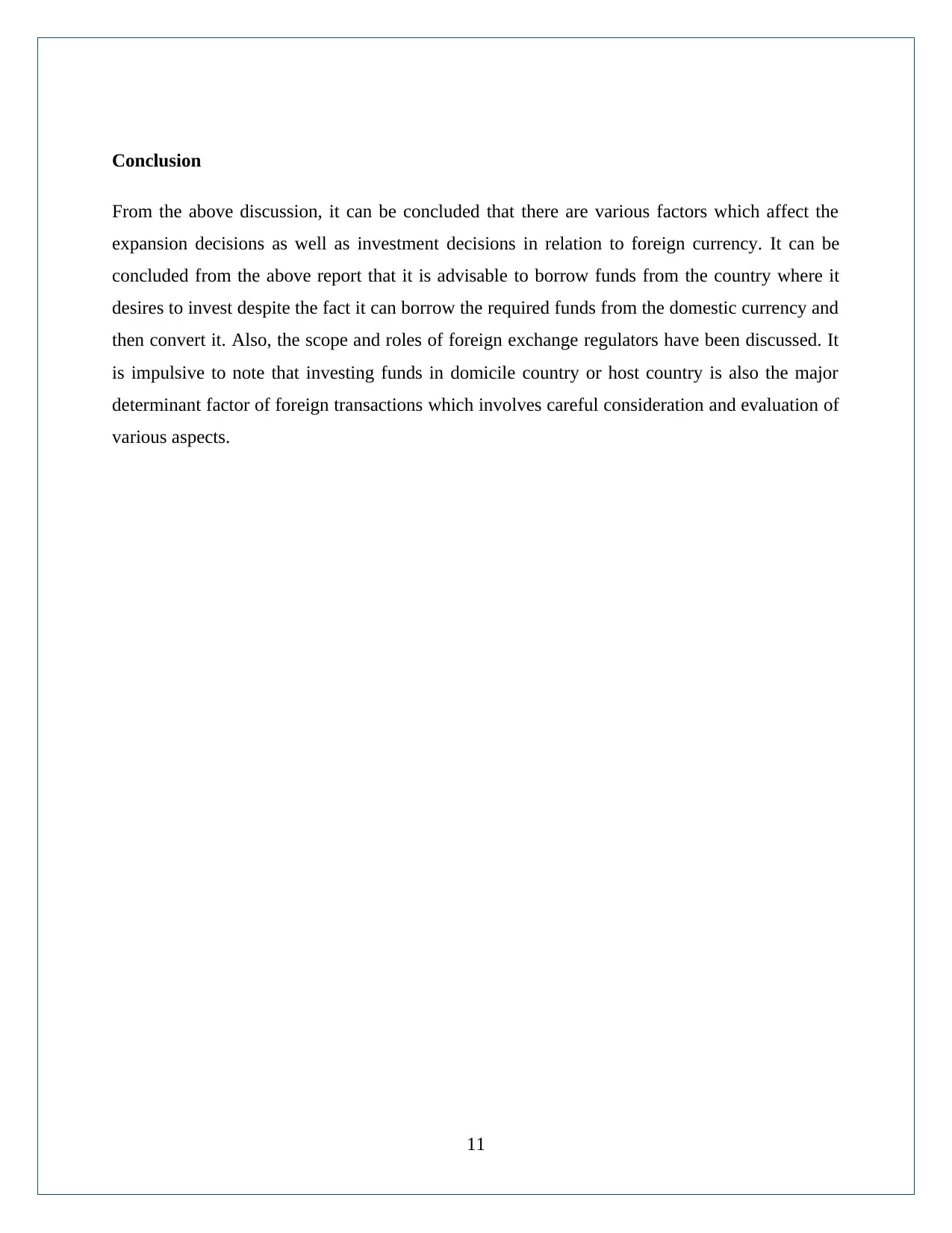
Conclusion
From the above discussion, it can be concluded that there are various factors which affect the
expansion decisions as well as investment decisions in relation to foreign currency. It can be
concluded from the above report that it is advisable to borrow funds from the country where it
desires to invest despite the fact it can borrow the required funds from the domestic currency and
then convert it. Also, the scope and roles of foreign exchange regulators have been discussed. It
is impulsive to note that investing funds in domicile country or host country is also the major
determinant factor of foreign transactions which involves careful consideration and evaluation of
various aspects.
11
From the above discussion, it can be concluded that there are various factors which affect the
expansion decisions as well as investment decisions in relation to foreign currency. It can be
concluded from the above report that it is advisable to borrow funds from the country where it
desires to invest despite the fact it can borrow the required funds from the domestic currency and
then convert it. Also, the scope and roles of foreign exchange regulators have been discussed. It
is impulsive to note that investing funds in domicile country or host country is also the major
determinant factor of foreign transactions which involves careful consideration and evaluation of
various aspects.
11
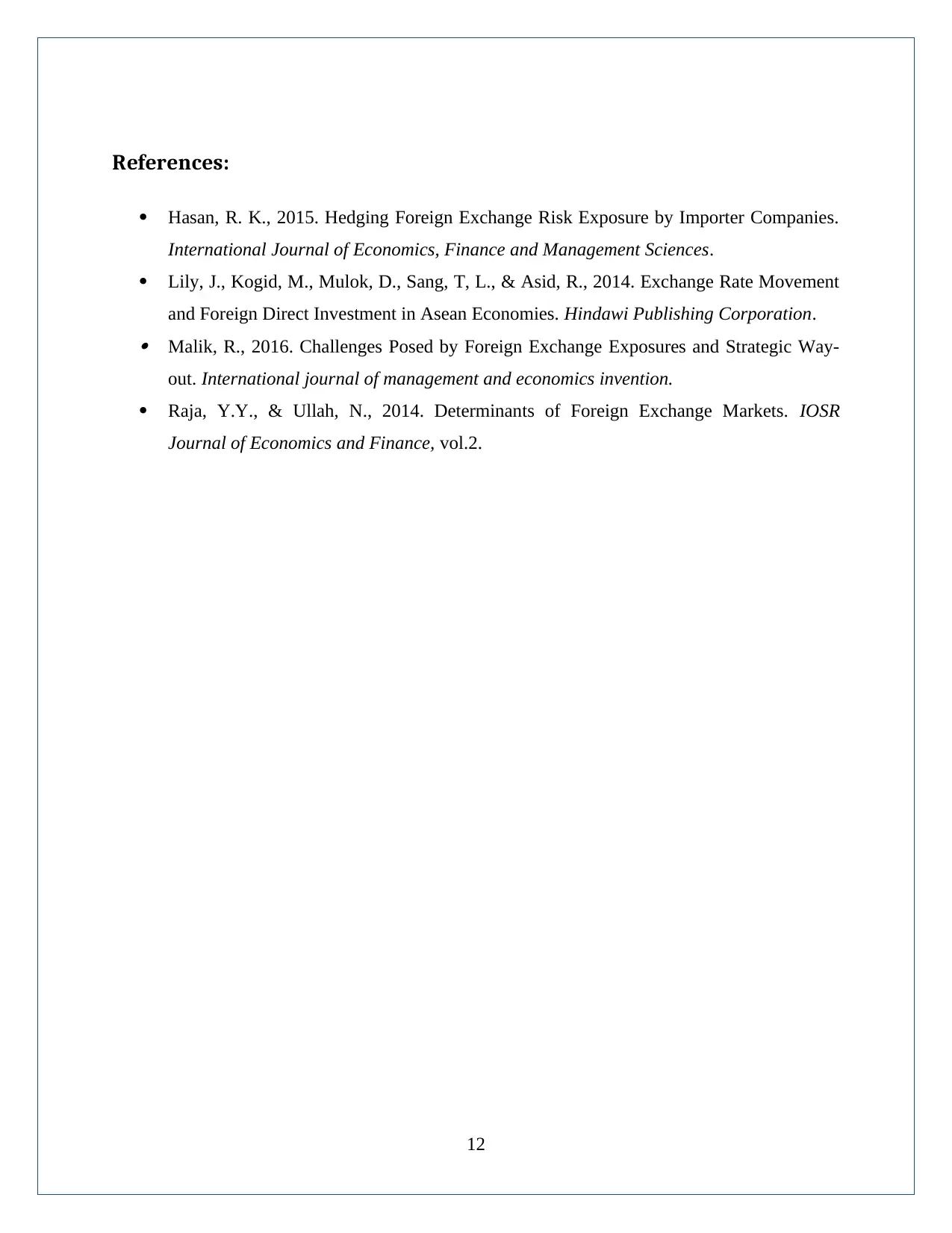
References:
Hasan, R. K., 2015. Hedging Foreign Exchange Risk Exposure by Importer Companies.
International Journal of Economics, Finance and Management Sciences.
Lily, J., Kogid, M., Mulok, D., Sang, T, L., & Asid, R., 2014. Exchange Rate Movement
and Foreign Direct Investment in Asean Economies. Hindawi Publishing Corporation. Malik, R., 2016. Challenges Posed by Foreign Exchange Exposures and Strategic Way-
out. International journal of management and economics invention.
Raja, Y.Y., & Ullah, N., 2014. Determinants of Foreign Exchange Markets. IOSR
Journal of Economics and Finance, vol.2.
12
Hasan, R. K., 2015. Hedging Foreign Exchange Risk Exposure by Importer Companies.
International Journal of Economics, Finance and Management Sciences.
Lily, J., Kogid, M., Mulok, D., Sang, T, L., & Asid, R., 2014. Exchange Rate Movement
and Foreign Direct Investment in Asean Economies. Hindawi Publishing Corporation. Malik, R., 2016. Challenges Posed by Foreign Exchange Exposures and Strategic Way-
out. International journal of management and economics invention.
Raja, Y.Y., & Ullah, N., 2014. Determinants of Foreign Exchange Markets. IOSR
Journal of Economics and Finance, vol.2.
12
⊘ This is a preview!⊘
Do you want full access?
Subscribe today to unlock all pages.

Trusted by 1+ million students worldwide
1 out of 12
Related Documents
Your All-in-One AI-Powered Toolkit for Academic Success.
+13062052269
info@desklib.com
Available 24*7 on WhatsApp / Email
![[object Object]](/_next/static/media/star-bottom.7253800d.svg)
Unlock your academic potential
Copyright © 2020–2025 A2Z Services. All Rights Reserved. Developed and managed by ZUCOL.





